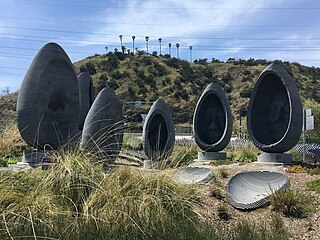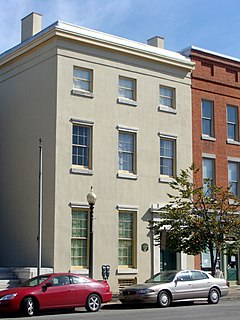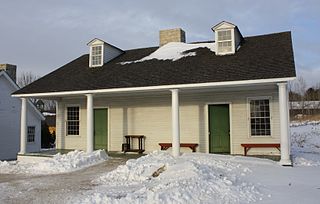
The Richard Nixon Birthplace is the birthplace and early childhood home of Richard Nixon (1913-1994), the 37th President of the United States. It is located on the grounds of the Richard Nixon Presidential Library and Museum at 18001 Yorba Linda Boulevard in Yorba Linda, California, and now serves as a historic house museum. Built in 1912 on family ranchland, it was home to the Nixon family until 1922. It was designated a National Historic Landmark in 1973, and is also a California Historical Landmark.

Klondike Gold Rush National Historical Park is a national historical park operated by the National Park Service that seeks to commemorate the Klondike Gold Rush of the late 1890s. Though the gold fields that were the ultimate goal of the stampeders lay in the Yukon Territory, the park comprises staging areas for the trek there and the routes leading in its direction. There are four units, including three in Municipality of Skagway Borough, Alaska and a fourth in the Pioneer Square National Historic District in Seattle, Washington.

The Victorian Village District is an area of Memphis, Tennessee.

Elizabeth Bay is a harbourside suburb in eastern Sydney, in the state of New South Wales, Australia. Elizabeth Bay is located three kilometres east of the Sydney central business district and is part of the local government area of the City of Sydney.

The Lundberg Bakery is a historic building in downtown Austin, Texas. It is located at 1006 Congress Avenue, half a block south of the Texas State Capitol grounds. It was added to the National Register of Historic Places on December 17, 1969.

Cypress Park is a densely populated, 82.1% Latino neighborhood of 10,000+ residents in Northeast Los Angeles, California. It sits in the river valley created by the Los Angeles River and the Arroyo Seco, and is surrounded by hills on three sides. It is the site of the Rio de Los Angeles State Park, the LA River Bike Path and other recreational facilities. It hosts one private and four public schools.
The Bates–Hendricks neighborhood is situated just south and east of the downtown commercial district of Indianapolis, Indiana. The Fountain Square business district is just to the east.

Lauraville is a neighborhood in northeast Baltimore, Maryland. The neighborhood is bounded on the east by Harford Road, on the north by Echodale Avenue, on the south by Argonne Drive and Herring Run Park, and on the west side by Morgan Park and Morgan State University, with East Cold Spring Lane passing through the center of Lauraville.

This is a list of the National Register of Historic Places listings in Brown County, Wisconsin. It is intended to provide a comprehensive listing of entries in the National Register of Historic Places that are located in Brown County, Wisconsin. The locations of National Register properties for which the latitude and longitude coordinates are included below may be seen in a map.

The Autrey Mill Nature Preserve & Heritage Center is located in Johns Creek, Georgia, U.S.A.

The Cashier's House is a three-story stuccoed-brick, Greek Revival building located on State Street in Erie, Pennsylvania. It was documented by the Historic American Buildings Survey in 1934. The house was listed on the National Register of Historic Places on January 13, 1972, and its boundary was increased on March 9, 1983.

Sabine Hill, also known as Happy Valley, Watauga Point, and the General Nathaniel Taylor House, is a historic house in Elizabethton, Tennessee. The two-story Federal style building was listed on the National Register of Historic Places in 1973. It is an excellent example of federal architecture. It was threatened by demolition in 2007 when the owners sought to have the property rezoned for apartments. The rezoning request was denied and the home was bought by several preservation-minded locals who secured it until the State of Tennessee/Tennessee Historical Commission could purchase the museum-quality property. It is now restored and opened to the public on November 1, 2017 as a unit of Sycamore Shoals State Park. The property is operated by the Park under a memorandum of understanding with the Tennessee Historical Commission.
Nils Otto Tank was a Norwegian born, Moravian Church missionary and teacher. He was a pioneer settler in Wisconsin.

The Baird Law Office in Green Bay, Wisconsin was built in the 1830s in Greek Revival style, which was then popular as one of America's first architectural styles that explicitly rejected British practices. The small one-story building measures just 16 x 30 feet (9.1 m) in size and served historically as a professional building.

Fort Howard Hospital is located within the Heritage Hill State Historical Park in Green Bay, Wisconsin. It was added to the National Register of Historic Places in 1979 for its historical significance in architectural, military and social history.

Tank Cottage is located within Heritage Hill State Historical Park in Green Bay, Wisconsin. It was added to the National Register of Historic Places in 1970.

The Cotton-Smith House is a historic house at 42 High Street in Fairfield, Maine. Built in 1890, it is one of Fairfield's finest Queen Anne Victorian houses. It was built by Joseph Cotton, owner of the Maine Manufacturing Company, which produced iceboxes, and occupied by him for just four years. The house was acquired in 1983 by the Fairfield Historical Society, which operates it as the Fairfield History House, a museum of local history. The house was listed on the National Register of Historic Places in 1992.

The Fort Howard Officers' Quarters, in Heritage Hill State Park at 2640 S. Webster Ave. in Green Bay, Wisconsin, were built in c.1816 or in 1830, according to various sources. They were listed on the National Register of Historic Places in 1979.
























